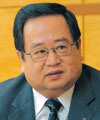Regional vitalization through HIKARI and NGN
—Mr. Kozono, please begin by telling us about the current environment surrounding NTT EAST.
The number of subscribers to NTT EAST’s FTTH (fiber to the home) service, FLET’S HIKARI (optical fiber broadband service) has exceeded 8 million and the optional services REMOTE SUPPORT SERVICE and FLET’S VIRUS CLEAR have over 1.5 and 1 million subscribers, respectively (Fig. 1). At present, however, the profile of new subscribers appears to be changing. Since most of the people who are familiar with the Internet have already subscribed to FTTH service, we have to attract those who are not familiar with it.
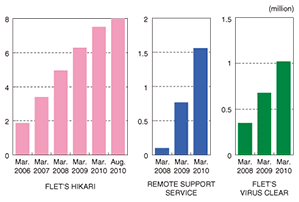
Fig. 1. Change in number of subscribers for various services.
Thus, in fiscal year 2010, we began to direct our efforts to attracting people who are not familiar with the Internet. We are also focusing on stimulating demand for video services, expanding the coverage area of FLET’S HIKARI services, and expanding the coverage of multi-dwelling units. We have also been promoting the connection of Wii game consoles to FLET’S HIKARI services, and the number of customers that connect to FLET’S HIKARI via only a Wii console without using the Internet from a personal computer has been increasing. To those who are not familiar with the Internet, this way of using FLET’S HIKARI services is also applicable. In addition, HIKARI and NGN services are particularly suitable for video. Given that the switchover to digital terrestrial broadcasting is scheduled for July 2011, we are working to get new customers to use HIKARI and NGN services. As for expanding the coverage area of HIKARI services, we are working with local governments on Indefeasible Rights of User (IRU) agreements and are expecting FLET’S HIKARI coverage to reach 96.5% within fiscal year 2010. Finally, we are promoting infrastructure development in condominium buildings and other multi-dwelling units through fiber optic cabling.
But this is not all. I also want to contribute to regional vitalization through HIKARI and NGN services. I come from Ibusuki City in Kagoshima prefecture. My hometown and other regional cities throughout Japan have an abundance of nature and many historical and cultural treasures that must be passed on to posterity. Moreover, many children live there, and they represent the future. When thinking about places to apply HIKARI and NGN technologies, one might think that metropolitan areas are typical, but in my opinion, it is regional cities and areas of declining population that need HIKARI and NGN services.
When I first came to Tokyo as a working member of society, I would use the red public telephones to make calls to my hometown. At a time when a three-minute call cost about 720 yen, I would make my calls after 8 pm when rates were cheaper, and I remember the jingling sound of my 10-yen coins as they dropped through the machine. Nowadays, you can make a three-minute call to anywhere in Japan for 8 yen!
These days, I often hear that people of my generation are worried about their parents being left in their hometown. I also hear that they are thinking of moving to a regional town to enjoy an easy-going life after retirement but are worried about whether they will be able to receive proper medical care. Thus, for people of my generation, it would be a great relief if HIKARI and NGN services could be used to make video calls from a metropolitan area to parents living in an outlying region, or to receive medical attention in a small town from a metropolitan hospital or doctor via videophone.
I believe that HIKARI and NGN services are also of great importance for children living in outlying regions. Children who want to study English, for example, could talk directly with a native English-speaking teacher or attend an English-language cram school by videophone. Of course, not actually being on-site has its drawbacks, but I think that with such services, it will be possible to obtain benefits similar to those gained from an on-site experience.
In this way, I would like to vitalize outlying regions by interconnecting regional cities and metropolitan areas—and indeed the entire country—through HIKARI and NGN services.
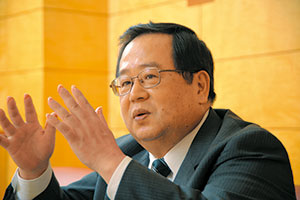
Turning to small- and medium-sized firms and firms with regional branches
—What is NTT EAST pursuing on the business scene?
Until recently, the Corporate Business Headquarters was making proposals to major enterprises and publicly held companies, but hardly any to small- and medium-sized firms. Since such firms make up the majority of Japanese companies, there still remains more for us to contribute. To rectify this situation, the Corporate Business Headquarters was integrated with the Office Users Business Division to establish the new Corporate Business Headquarters, whose role is to make proposals to all types of firms—from small- and medium-sized firms to major enterprises—as well as to set up functions and systems to expand business activities. In this new Corporate Business Headquarters, we are trying to promote the sharing of the advantages and know-how between the former two divisions and also the vitalization of regional areas.
—Could you give us some specific examples?
In the case of small- and medium-sized firms, many have already introduced HIKARI services such as HIKARI DENWA (denwa is the Japanese word for telephone) in their headquarters or main offices but not in their regional branches (Fig. 2).
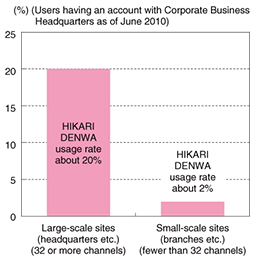
Fig. 2. Size of user base versus HIKARI DENWA usage rate.
Office information technology (IT) equipment that can connect to the network is proliferating, and as a result, the customer’s usage environment is becoming increasingly advanced and complicated. In such an environment, customers are finding it more difficult to discover the cause of trouble in office equipment by themselves, so it takes much time for them to solve the problem.
In small- and medium-sized firms, it is difficult to set up an in-house IT support section. I believe that following up on this need could be a great opportunity for NTT EAST. OFFICE MARUGOTO SUPPORT (total office support), for example, could provide a range of services, from virus protection to software management and remote support services.
Targeting small- and medium-sized firms for new business could lead to a big increase in the number of customers, and our current method of providing services will not be able to handle this surge in new customers. For this reason, I think that we need to utilize various types of media and the web to convey in an easy-to-understand manner the attractive functions of our services and to just let companies know what we can offer. We must also respond to all inquiries to avoid losing opportunities. I would like to satisfy the needs of such a large number of customers even with the same number of staff.
—You describe the current business situation in very realistic terms. Your past experience must be of great value here.
Well, I’ve had a long experience of working in NTT regional branches. I’ve spent lots of time working closely with customers, which gave me many opportunities to listen to their problems and develop a good understanding of what they find troublesome or perplexing. I also think that this experience has helped me to learn how to apply our technologies in an optimum way. Moreover, while listening to customers during my times as a branch manager, I came to understand their anxiety over the education of children and medical care for the elderly in regional areas, and I developed a strong desire to do something about solving those problems.
Furthermore, within our company, I used to be involved in network construction, and this has proved to be very useful in my present work of corporate and office sales. To my colleagues in corporate and office sales divisions, I can offer some thoughts as a network staff member, and on the other hand, I can get them in touch with my colleagues on the network side. I have a strong desire to contribute to the company as someone who can bring knowledge of both networks and corporate and office sales to the table. I would like to harness my strengths in both of these areas to create services and solutions for regional vitalization.
Nurturing technologies that can flourish in the market
—You are concurrently serving as President of NTT Vietnam. What are your thoughts on NTT EAST’s international business, including NTT Vietnam.
NTT Vietnam is providing constructional and operational assistance of 240,000 analog telephone lines in the northern part of Hanoi, the capital, based on a business cooperation contract with Vietnam Post & Telecommunications (VNPT).
In Vietnam, there is still little awareness of making good use of fiber-optic services for business. My aim, therefore, is to convey the positive features of HIKARI and NGN services to relevant people in Vietnam and to get them to use NTT technologies. Then, with the experience gained through this effort, I would like to expand HIKARI and NGN services to other countries.
Specifically, I am beginning this effort with industrial complexes, which can easily benefit from HIKARI services. In cooperation with VNPT Hanoi, we began an FTTH field trial in 2007 at Vietnam’s Thang Long Industrial Park 1 and launched commercial services in September 2009. We also began a similar trial at Vietnam’s Nomura-Haiphong Industrial Zone in cooperation with VNPT Haiphong in 2009.
In Indonesia, meanwhile, NTT EAST was put in charge of supervising the construction of an optical access network at East Jakarta Industrial Park in 2009. And in June 2010, PT Telkom Indonesia and NTT EAST exchanged memorandums on establishing a cooperative relationship to construct optical access networks and develop maintenance and commercial services.
People in Asia and Europe are beginning to take an interest in HIKARI and NGN services, and increasingly overseas parties make contact with us in this regard. I have a feel that there will be a growing need throughout the world for NTT EAST’s optical access service technologies.
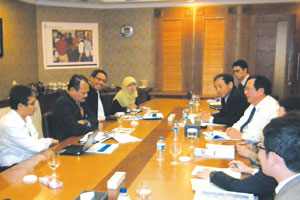
—Mr. Kozono, could you leave us with some words for researchers?
Did you have a chance to see the “World of Toy Story 3” Exhibition*? Wasn’t the tenoripop [1] technology amazing? An image is projected on your left hand and another image on your right hand, and yet another image is created by bringing your two hands together. This is technology from NTT Laboratories. The people at Pixar, which produces the Toy Story movies, seemed to enjoy this technology very much at the exhibit. To connect such amazing technology with business, it’s important to observe customer reactions up close and to reflect customer needs in technology.
New network services like the NGN have already been launched against the background of NTT Laboratories’ development expertise in network-construction technologies. From here on, I would like to see NTT Laboratories work to develop application services that can make good use of the network. NTT business companies and NTT Laboratories are increasingly working together from an early stage to advance development projects. For example, the assembly record system introduced by Japan’s House of Representatives makes practical use of high-accuracy voice-recognition technology developed by NTT Laboratories. This system could easily be expanded to prefectural assemblies as well as to a wide range of business tasks such as transcribing a writer’s notes and recording a company’s meeting minutes.
Such success stories are still few in number, and we need to nurture technologies that can flourish in the market. To this end, I would like to see researchers visiting NTT business companies—which are in close contact with customers—so that we can create compelling products together.
Although our expectations of NTT Laboratories are great and our encounters with research personnel may sometimes result in frank talk, we should continue to engage in spirited discussions and move forward. Let’s create technologies that our customers will really enjoy!
| * |
“World of Toy Story 3” Exhibition: Held from July 1 to September 5, 2010 at NTT InterCommunication Center in Shinjuku, Tokyo. |

Reference
↑ TOP

